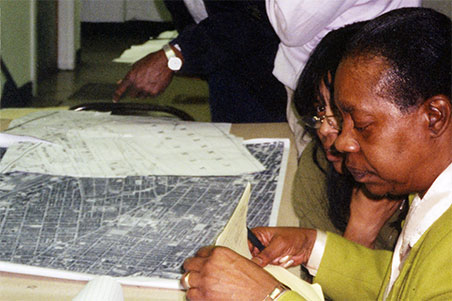
In spring 2000, Mill Creek Coalition (MCC) officers Crystal Cornicher (President) and Preston Nasir (Vice President) joined WPLP director Anne Spirn and research assistants Carla Radoslovich-Delcambre and Rafael Jiminez in offering a class on the History and Development of Mill Creek. The Coalition held a half-dozen classes at the Mill Creek Community Center (a now defunct organization that was run by the Mill Creek Jazz and Cultural Society). Crystal recruited local leaders who were active in community affairs, including volunteers from several neighborhood churches. Overall, the course attracted a wide range of age groups, including long-time Mill Creek residents and newcomers.
The course featured educational materials that Spirn and her students had developed with for use at Sulzberger Middle School. Specifically, the course used flashcards designed to help students interpret primary documents, like historic photographs and maps, in order to learn about their neighborhood evolved. The front of each card displays a primary document and leading questions (whose answers can be found in he document), while the reverse side offers another, related primary document with amothre series of questions. Although the materials were created for eighth-graders, the course offered a chance to test the materials and share them with adults interested in learning about their neighborhood.
The flashcards were popular, and the course was a powerful experience. Many residents, even those who had lived their entire lives in Mill Creek, had not known how their neighborhood came to be and were unaware of patterns that were impacting Mill Creek as a whole. The course offered the opportunity for them to place their own personal memories into a larger context. As they learned about past events, residents came to see their experience as part of a much bigger picture: the larger environmental, political and economic shifts that occurred in both Philadelphia and the nation.
For the Mill Creek Coalition, the history course explained policy decisions that have historically impacted their neighborhood.
For WPLP staff, the course demonstrated the value of local history in working with a community to develp ideas for the future. The history of a neighborhood is the context for all that is happening in the present. In order to lay plans for the future, one needs to understand how that neighborhood came to be. Through an understanding of how their neighborhood came to be, people not only can form a vision of what their neighborhood could be, but also understand how to make that vision a reality.